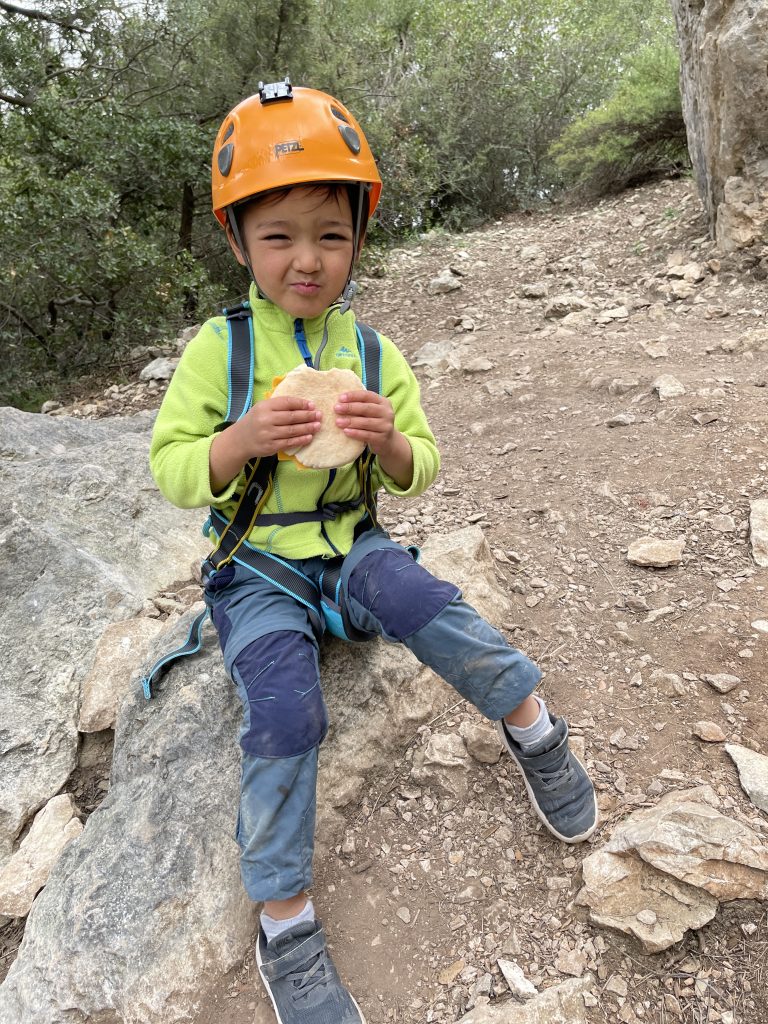
Table of Contents[Hide][Show]
- Why Rock climbing? Develop important life skill sets.
- Climbing with Kids: Minimum age requirement?
- Bring Plenty of Entertainment, Snacks, Treats on Outings
- Climbing with Kids: Safety
- Manage Expectations and Have Fun!
Climbing with Kids: Tips on Getting Started+−
- Start with Playgrounds, Scramble
- Try Bouldering or Low Climbing Structures
- Try an Indoor Climbing Gym
- Venturing Outdoors to Top-rope Climb
- Climbing Gear for Kids – Getting Started
- Basic starting gear
- Bouldering
- Indoor climbing
- Tips when getting started climbing outdoors
- Climbing with Kids: Learning to rappel
Why Rock climbing? Develop important life skill sets.
Most active sports for kids require strength, speed and agility, which may make it challenging or intimidating for kids just starting out.
Climbing offers an alternative where calm, calculated movements (think more like a board game) can help build confidence, focus, balance, endurance, problem-solving and decision-making.
In fact, as an adult, I find climbing outdoors to be very meditative!
Climbing with Kids: Minimum age requirement?
If you check out climbing courses, many will list a minimum age of 5+, though depending on your child, he/she can start much earlier. Climbing uses a natural movement for kids, especially if they’re already little monkeys on play structures and have been exposed to scrambling on natural rock formations.
Our daughter at 2 was already climbing, and yes, there are special sized full body harnesses for the wee ones (more on that in the equipment section).
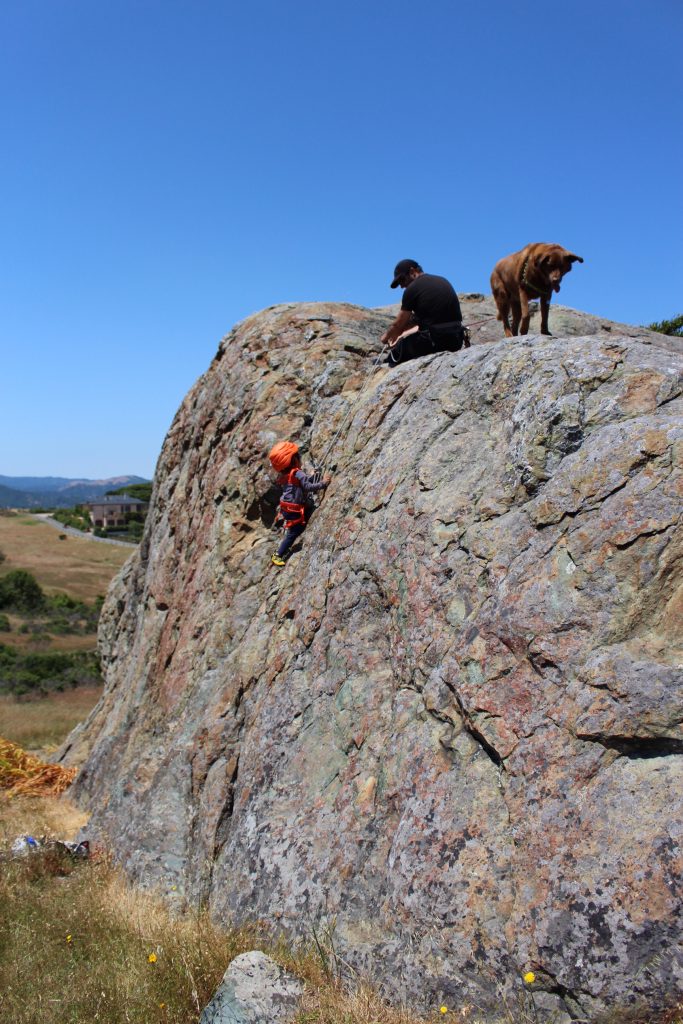
Though it may seem that climbing requires a lot of brute upper body strength, it’s actually more important to learn about balance, positioning and shifting your weight when starting out.
Strength-to-weight ratio becomes important as one advances, but it works to little ones advantage because they are so much lighter and don’t need as much muscle in the beginning.
Bring Plenty of Entertainment, Snacks, Treats on Outings
If you’re reading this, you likely already know that outings with children often require some form of fun factor: entertainment, snacks, treats, etc – beyond the actual activity. Climbing is no exception!
Climbing at a gym or outdoors (bouldering, sports climbing, via ferrata, etc) is an adventure in of itself. That being said, only one climber can climb while one belays (the person who controls the safety rope for the climber). That means if you’re going out with just your immediate family, only one person is actively climbing while the others support or wait.
Our kids are ages 4 and 6, so they can now mostly keep themselves entertained with snacks and the surrounding environment (as long as it’s safe to do so). But when possible, we highly recommend going with other families, so you can help each other supervise the kids (especially if they are young), but also to increase the fun factor.
If you’d like to try a family-friendly gym, call a few in advance and ask if they have a special climbing area just for kids.
If you’re ready to try climbing outdoors, we recommend letting your child bring along a game or a few toys to play with while waiting for their turn.
Climbing with Kids: Safety
If you’ve never climbed before, and you don’t have any experienced families to go with, try a climbing course at a local gym or one that offers outdoors classes.
It’s important to learn the basics before attempting to do anything on your own. That includes equipment, proper care and handling, awareness of surroundings and others around you, and form and technique. Climbing is often not too difficult to get the hang of, but rappelling (the act of descending back to the ground) can be tricky for beginners as it isn’t as natural a movement.
Kids, especially young ones, require a lot of attention when climbing. Even with experience, we recommend going with other families so there’s always another responsible adult supervising the kids and the person belaying can focus on the safety of the climber and doesn’t get distracted.
Manage Expectations and Have Fun!
Just like any other activity with children, we have to adapt our pace to them. Hiking, biking, climbing, whatever the activity is – we need to remember to manage our expectations and remember that this outing is for them. This is especially important if you’re used to adventures before kids!
There have been occasions when we’ve lugged out all the gear, hiked in 1 hour only to get in 1 climb each (if that!). Be prepared for everything to take longer than anticipated and for typical setbacks like
- kids getting tired, complaining or unmotivated on the approach (if heading to an outdoor area)
- kids getting bored waiting for their turn
- kids getting a bump, bruise, scrape or two on the way in/out, or while climbing/rappelling
- kids bickering and fighting (over whose turn it is, a toy, a twig, a rock, etc)
If your kid attempts to climb and enjoys him/herself for even 5 minutes, celebrate it as a huge win for the day!
As I mentioned above, we do get frustrated as I’m sure you have as well, when you had high hopes and expectations for a fun-filled day. What keeps us going? We know that when we have the opportunity, we do take time to enjoy ourselves (e.g. kids go to snow school so we can hit the slopes!).
The biggest reward is when your child has had an incredible adventure and can’t wait to do it all over again (sometimes our kids ask to do the same thing again the next day!).
Climbing with Kids: Tips on Getting Started
Start with Playgrounds, Scramble
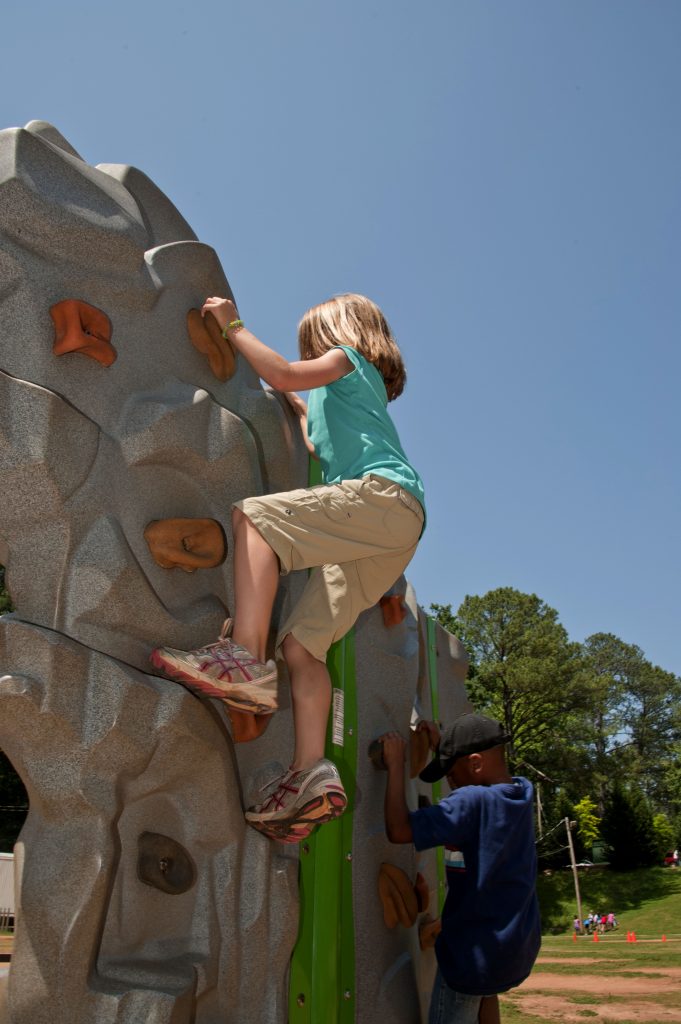
Even without climbing gear, you can start to expose your little ones to the experience of climbing and gaining confidence in their abilities.
Toddlers can climb and scramble in playgrounds (many playgrounds now include a low wall with climbing holds!) or on natural rock formations while exploring outdoors.
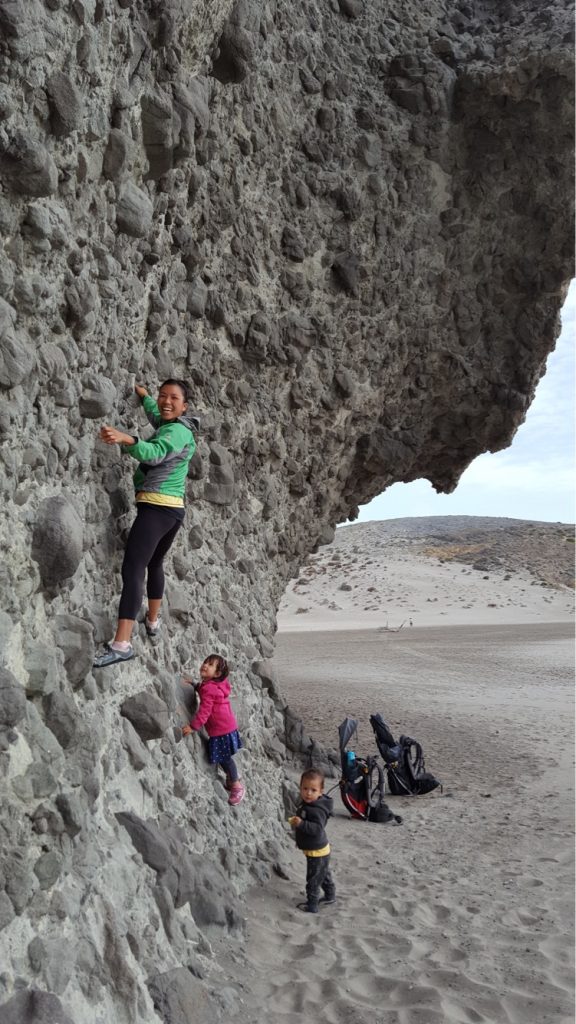
Family friendly climbing gyms have great areas for kids where they can play and climb without a need to wear climbing harness or use rope. They also have thick mats in case they fall.
Try Bouldering or Low Climbing Structures
Before moving onto top rope climbing (especially if your child has some fear of heights), we suggest trying out bouldering and/or low climbing walls first (can be indoor or outdoor). When starting out, you don’t need any special gear, as long as you have a spotter and you aren’t climbing higher than your spotter’s reach.
If your child wants to try something more challenging, ask them to try moving horizontally, instead of higher on the wall.
If your child is going to climb higher than your reach, we recommend a helmet and a crash pad (we recommend going with friends to try it out first!). Most people don’t wear helmets bouldering but for safety reasons, we recommend it.
Climbing shoes are optional but can be invested in if your child is interested in advancing.
Try an Indoor Climbing Gym
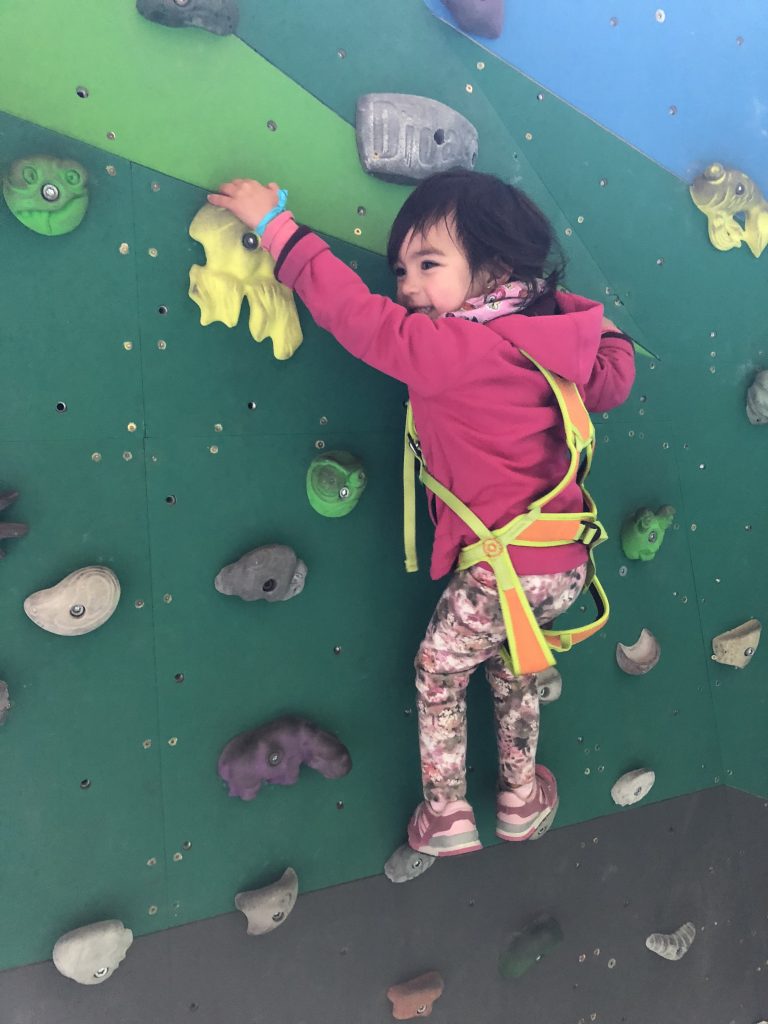
If your child is ready and excited to try climbing with a top rope, try a beginner’s course at a indoor climbing gym class.
They will learn how it feels to be in a harness, names and usage of equipment and climbing commands (specific language to use while climbing), how it feels to tackle different climbing holds (you can even play games by following only certain color holds), how to descend with proper form (rappel) and trusting the belayer and equipment to protect them from falls.
Kids won’t learn everything right away but it’s great to get them introduced to all the concepts. Our 6 year old daughter was introduced to the figure 8 knot years ago, but it wasn’t until this year that she was really interested in learning to make it herself and has now mastered it!
You can also explain the difference grading systems for the levels of climbing routes (here in Europe, we use a difference system than in the States). This can help them understand what are suitable routes for their level and allow them to check out maps and choose ones they want to try.
Venturing Outdoors to Top-rope Climb
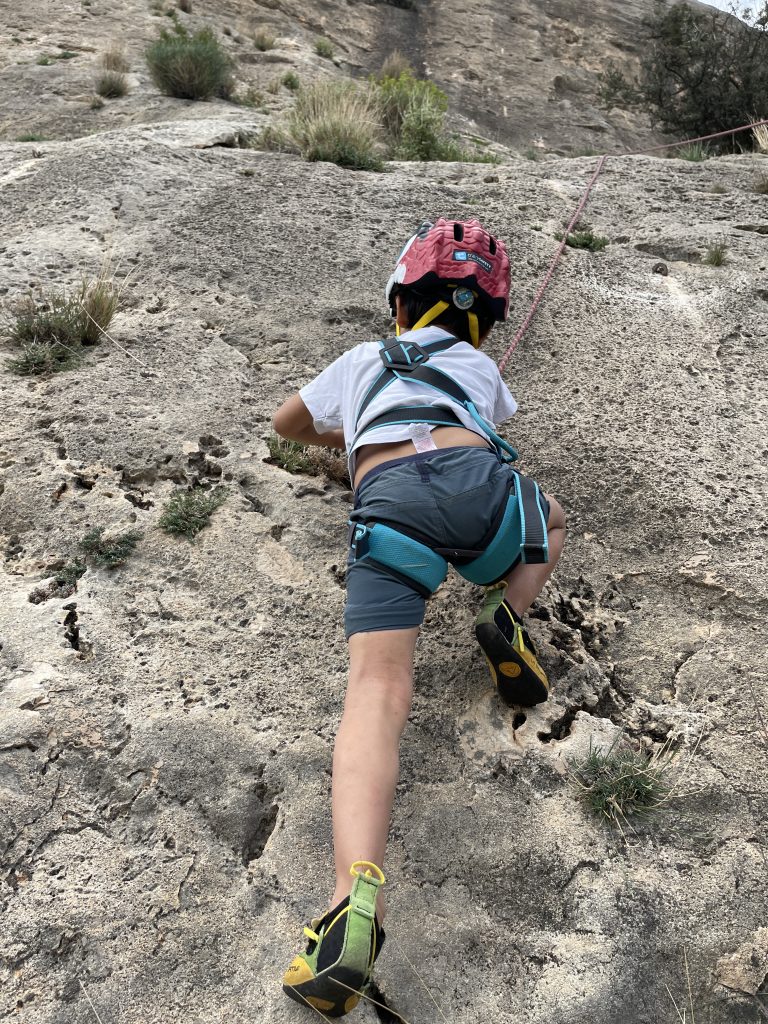
Once your child is ready to try venturing outdoors to top rope climb, remember our managing expectations tips above. We had zero expectations with our daughter and at 2.5, without hesitation she surprised us by climbing her first natural wall on her own (see the above photo). It helps a lot to go with friends and for her to see other kids climbing too. It makes new things seem less scary.
As our daughter grew older and more aware of her surroundings, she became more fearful. We let her climb as much as she wanted but only to where she felt comfortable.
Two weeks ago, we went climbing as a family and our daughter, now 6, said she didn’t think she could do it. I told her that we weren’t going to push her to do anything she didn’t want to do, but that new things always feel a little scary, that we believe she can do anything and that the only person that could tell her that she couldn’t do anything, was herself. That day, she climbed her first full route! She was so proud (as were we!) and she insisted that we go climbing again the next day 🙂
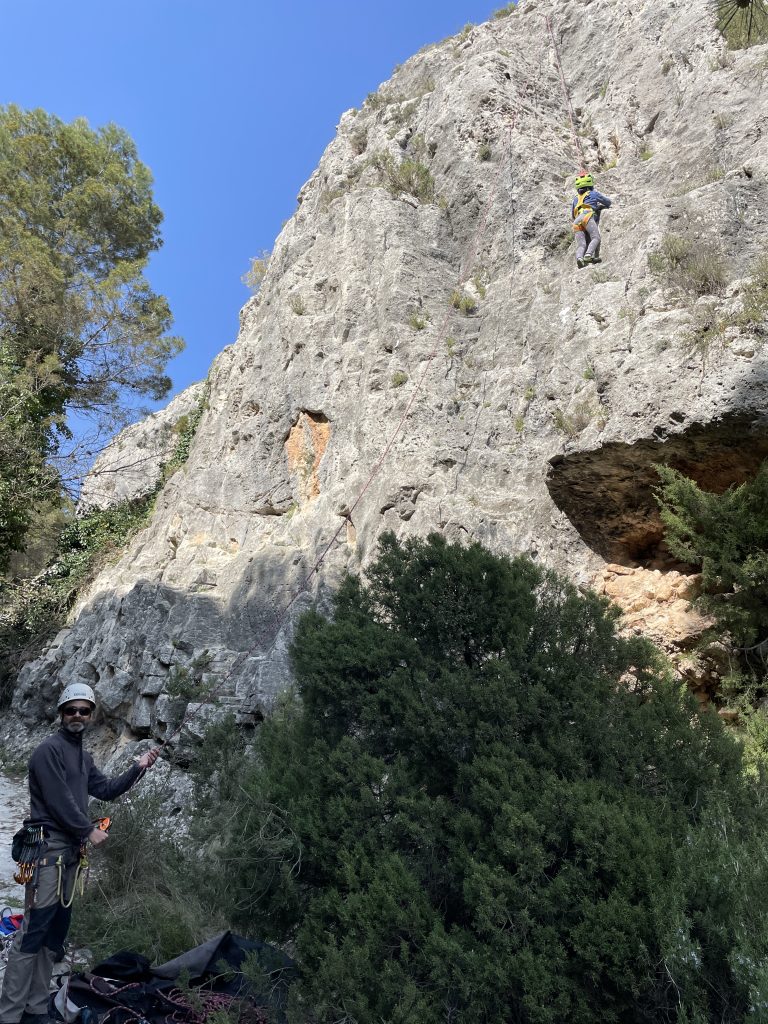
If you want to go climbing outdoors, make sure to keep the following in mind:
1) Choose an area where the approach (the distance from where you park to the climbing wall) is short and easy. This, of course, depends on your child’s ability. You may want to consider bringing a hiking child carrier. We know kids as young as 2-3 who are accustomed to longer treks and have no issue with this but our son for example, wasn’t able to do longer hikes with us on his own until he was about 3-4.
2) Make sure you check the grades of the routes on the wall before going to ensure they have easy routes for the little ones
3) Only consider areas that either you’re visiting with a professional group or that a trusted friend or you’ve personally visited before and consider safe for your little ones. Though there may be plenty of easier climbing routes, sometimes the approach or the waiting area can be steep and slippery and not appropriate for young ones.
If you’re just starting out, for the reasons listed above, we highly recommend learning in a supervised climbing gym first and going to areas you are already familiar with or with experienced families who knew child friendly areas.
Climbing Gear for Kids – Getting Started
We keep saying it but the best way to get started is with friends! If you have friends who have kids that climb, ask to tag along. You can also buy gear second hand but we haven’t done so because we don’t know how the gear has been handled. So only buy second hand if you trust the source (e.g. a reputable store).
Since only one kid is climbing at a time (unless there are multiple ropes, equipment and people to belay), kids can share equipment (as long as their equipment can be adjusted to fit your child).
If you want to purchase equipment like helmets and climbing harnesses, we recommend going to a special outdoors store and getting fit. The little ones need full body harnesses for example.
TIP: if you already know your child’s size, buying equipment from last season reduces cost!
Basic starting gear
As we’ve mentioned above, getting your kids outside and climbing naturally is important to nurture their interest and confidence. All you need is a good pair of hiking shoes or sports shoes with traction for hiking. With supervision, allow them to climb natural rock formations.
Bouldering
As mentioned above with bouldering, no equipment is needed when starting out. If your child wants to continue bouldering but not ready to top rope, investing in a helmet, climbing shoes and a crash pad can help them advance their skills.
Indoor climbing
Harness
When your child starts top rope climbing, you’ll want to invest in an appropriate harness for their size. Little ones will need a full body harness (typically under age 7) as these include a tie-in point at chest level to help prevent kids from falling out of their harness.
There are a number of reputable brands. We’ve personally tried and like Petzl, Edelrid, Rock Empire.
Climbing shoes
Climbing specific climbing shoes are not necessary as your child can climb with sports shoes until they start doing harder routes and need some stick on the soles of their shoes. The tight fit and rubber soles of climbing shoes help with getting good foot holds in small crevices and smooth rock.
We highly recommend Stickits by La Sportiva (they are the green and yellow pair you see our kids wearing in the photos). Kids grow quickly so it’s great that this pair is adjustable in the heel and can grow with them through a couple sizes.
Climbing Helmet
Climbing helmets were first made to protect from rocks and things falling from above (not necessarily to protect from head injuries from a fall). In recent years, newer helmets are now being made to protect from falls as well.
Our kids are accustomed to wearing helmets for biking, riding the scooter, skiiing/snowboarding etc so they had no problem wearing one for climbing. Though it’s recommended to use a climbing specific helmet (we borrowed from friend’s previously), we have used their bicycle helmet in the past and are OK with this because our kids were not climbing high.
It was meant more to get them in the habit of wearing a helmet for these kinds of activities. As we are experienced climbers and knowing that climbing helmets weren’t previously built to handle impact from falls, we were comfortable with making this judgement call.
That being said, please note, this is not professional advice. For full safety, use a climbing specific helmet.
Outdoor Climbing
Beyond the equipment listed above for Indoor Climbing, you’ll also need:
Rope, Quick Draws and Belay Equipment
I won’t go into detail here about this equipment because if you are indoor climbing, the gym should have this equipment available for use. If you are outdoor climbing, I assume you or someone you are going with is experienced and already has the required equipment.
Tips when getting started climbing outdoors
Climbing indoors is very different than climbing outdoors. We much prefer climbing outdoors but indoor climbing and climbing walls have their advantages.
With climbing walls, there are colors and specific handholds you can eye and you can set up different routes and climbing difficulty from the same wall.
You can’t change the difficulty of a natural climbing wall, and figuring out where your hands and feet can go is more challenging. Sometimes, other climbers leave chalk marks so you can see where others have placed their hands. But more often than not, you may not be able to see ahead.
Little steps
One of the tips we recommend for everyone, adults and children alike, is to take it little step by little step. Sometimes, it may appear we have no holds, but lifting your foot just a few inches will allow you to find a hand hold that you couldn’t see before.
Give a little lift
Climbing is a natural movement, but being strapped into a harness, with a helmet and hanging on a rope can make some kids uncomfortable. If your child is just starting out, help boost their confidence by giving them a “lift”. You can accomplish in a few ways. One is if they are low on the wall, you can use your hand to stabilize a foot hold, or giving them a boost from their bottom.
And we don’t recommend doing this often, but if your child is attempting a challenging climb for the first time, it is possible to give them a lift by tightening the rope to give them a boost to the next hold.
Climbing with Kids: Learning to rappel
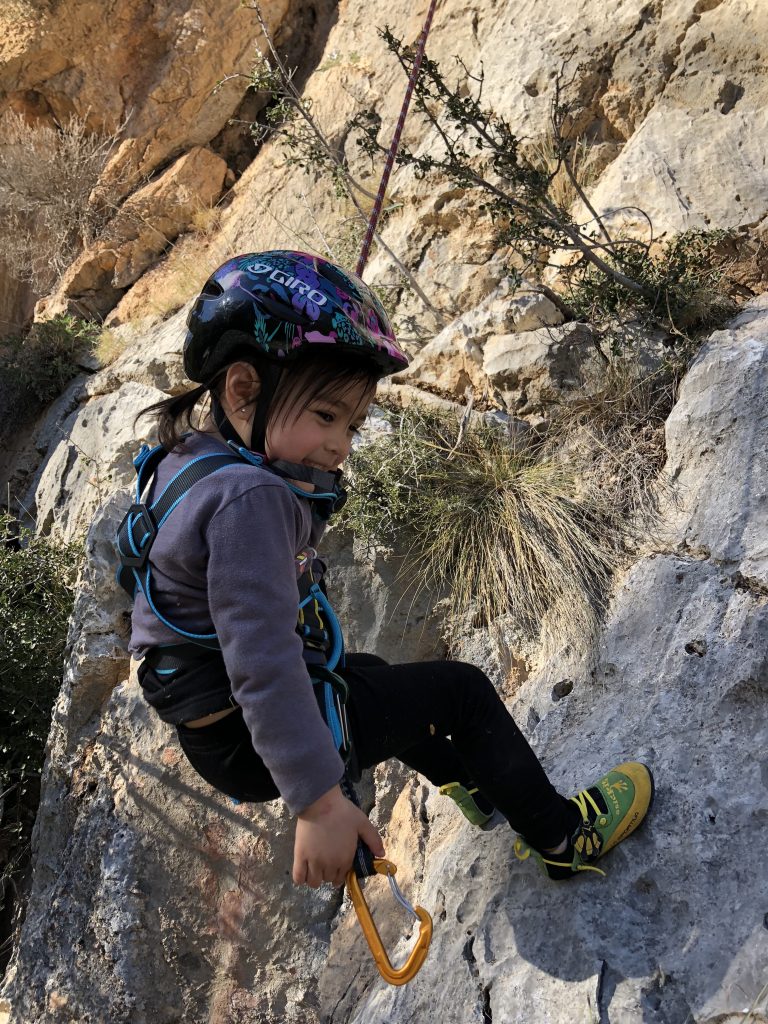
Our kids struggled with rappelling. Climbing will feel like a more natural movement, but the descent, especially from a high position, can feel scary, especially if they are not comfortable with the proper rappel position.
Our kids have climbed down numerous mountains and rocky areas before, but the combination of height and releasing all your weight into the rope is a scary sensation. They also need to practice the sitting position with their feet pressed up against the climbing wall, and their legs in a shoulder wide position to help with stability as they are descending.
If their feet are too close together, your child will lose balance and their bodies can spin toward one side or the other and they body can hit the wall (this happened to our son recently and he got a scrape on his elbow, but he quickly got over it!). Then it feels scary to get back into position.
Tips for teaching your child to rappel:
- Teach your child the rappel position at a low height, preferably in an indoor climbing gym (if you’re doing it outdoors, it will work too – our kids learned outdoors).
- Tell them to imagine they are sitting in a swing.
- Tell them to look straight out at the climbing wall.
- Ask them to place their feet flat on the climbing wall, shoulder width apart. The motion should feel like they are walking down the wall, while in the sitting position.
- They should be able to see where they are placing their feet, but they should not shift their head to focus on any other area besides in front of them (e.g. to the sides, or down at their feet as that will shift their bodies/chest towards the climbing wall and they will lose balance).

Thanks a lot for sharing such a great piece of article! I found it a good helpful write-up with a good sound and explanation. Here I have seen some valuable ideas that are definitely helpful for every climbing enthusiast who wants to climb with kids. Please keep sharing more updates!